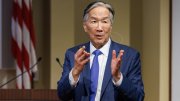In the wake of Harvard’s December announcement, a host of other institutions—Haverford, Penn, Pomona, and Swarthmore among them—said they would replace loans with grant aid. (All such programs are tracked at the Project on Student Debt, https://projectonstudentdebt.org.) But from the Cambridge vantage point, the most interesting news came from Yale, which had also been reviewing its aid policies when Harvard publicized its new program. The Eli decision was double-barreled.
On January 7, Yale president Richard C. Levin announced that his institution would lift its targeted annual distribution from the endowment to a range of 4.5 percent to 6.0 percent of the value of the funds; the nominal payout ratio had been raised to 5 percent in 1995 and to 5.25 percent in 2004. To effect that change, he said, the distribution for the 2008-2009 year would rise 37 percent, to $1.15 billion, from $843 million in the current fiscal year. The huge increase would be used to enhance financial aid; to make Yale’s intellectual capital more available to the public (on line and, perhaps, on campus, by expanding the undergraduate student body 13 percent, to 6,000); and to accelerate biomedical research by developing a 136-acre pharmaceutical campus in West Haven purchased last fall.
Some perspective: Yale is less than two-thirds Harvard’s size, measured by total enrollments and endowments ($22.5 billion versus $34.9 billion last June 30). During fiscal year 2007, Harvard distributed $1.04 billion from the endowment for operations (a 4.3 percent distribution rate in the University accounting), plus additional sums for one-time “decapitalizations” and for the annual assessment for Allston campus development costs; in sum, Harvard now aims to have an “aggregate spending rate,” for all three categories of distributions, that totals 5.0 percent to 5.5 percent of endowment value. In the near term, absent a change in University policy, Harvard’s regular endowment distribution for operations might be only slightly greater than Yale’s, measured by dollars spent.
On January 14, Levin unveiled Yale’s aid package, which in some ways goes beyond Harvard’s. It eliminates loans, applies the 10-percent-of-income formula to families with up to $200,000 of income, and expands expense allowances during school vacations for foreign students. It exempts the first $200,000 of family assets, if not all home equity, from aid calculations. In illustrating its package, Yale emphasized significant reductions for families educating more than one undergraduate at a time, and estimated that the average cost of enrolling a child would be reduced by more than half for families with financial need. An on-line calculator will help families estimate the net cost of attendance. Paying for the new program will cost “more than $24 million,” increasing the aid budget to “over $80 million annually”—implying a spending increase of perhaps 40 percent. Yale will also limit the increase in its term bill for next year to the expected level of general inflation, 2.2 percent. (Harvard’s 2007-2008 term bill increased 4.5 percent.)
While the two universities with the world’s heftiest balance sheets battled it out, various educators had somewhat critical perspectives on the escalating aid offers, particularly to upper-income families. The Chronicle of Higher Education quoted Robert J. Massa, a vice president at Dickinson College: “Harvard, Yale, and other mega-rich universities…are applying a ‘percentage of income’ contribution because they can afford to do so—not because it is right.” Similar sentiments reported in the New York Times, Washington Post, Boston Globe, and elsewhere summed up fears that the few dozen richest institutions are, in effect, moving beyond need-blind aid toward merit scholarships—thus forcing less-endowed competitors to ramp up their own spending even for affluent students, depleting the ability to focus aid on financially needy applicants. Pomona president David W. Oxtoby ’72 told the Times that if other schools headed in that direction, “[T]hat would be terrible, exactly the wrong outcome.” Some public university leaders expressed apprehension that elite private institutions are taking advantage of budget constraints affecting state support for higher education—even as they wanly hoped the new round of aid programs would focus legislators’ attention on the need to boost scholarship funding.
Reacting to such concerns, Levin told the Washington Post, “If we don’t spend our resources for a social good, we are criticized. If we do…we are criticized. We are trying to strike a balance.”







